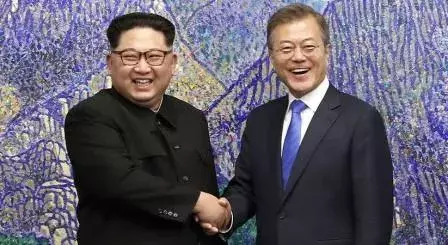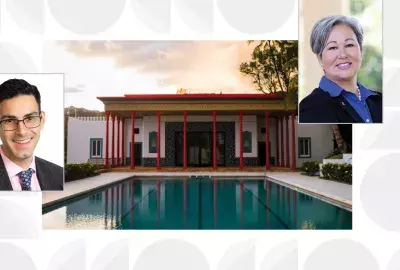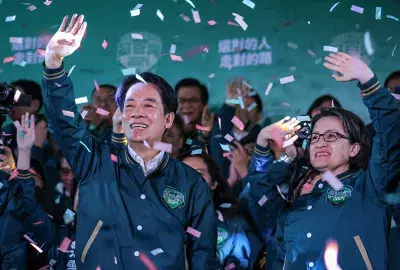Error message

By Denny Roy
HONOLULU (May 6, 2018)—In late 2017, a US preventive military strike on North Korean territory, which risked escalating into a new Korean War, looked likely. Washington had led a campaign, most importantly including China, to squeeze North Korea with economic sanctions. But North Korean leader Kim Jong-un persisted with testing and eventually demonstrated that a North Korean missile could probably reach the US east coast. That brought North Korea close to achieving a capability US President Donald Trump had promised “won’t happen.”
This left Kim with two imminent problems. The first was the economic sanctions, which were causing his country considerable hardship. The second was the possibility of a US strike on his nuclear and missile facilities. If this occurred, Kim would have two choices. He could respond with a retaliatory military attack on South Korea or on US bases elsewhere in the region, which would almost certainly lead to the swift destruction of his own regime. Or he could forebear from serious retaliation, thereby proving his country had no practical recourse against American attacks.
This explains Kim’s peace offensive in 2018. In January he declared his nuclear weapons program “completed,” and has conducted no observable bomb or missile tests since then. Using South Korean officials as go-betweens, Kim offered to meet Trump to negotiate “denuclearizing the Korean Peninsula.” He reiterated this message during the summit with Republic of Korea (ROK, South Korea) President Moon Jae-in last month. That phrase made a meeting with the US president possible, because it met a long-standing US precondition that North Korea must be willing to put its nuclear weapons on the bargaining table.
The Kim-Trump summit is planned for late May or June. Kim has a huge advantage: it is relatively easy for him to get what he wants. The Chinese government has already indicated that outside countries should reward Pyongyang for its diplomatic outreach, suggesting the Chinese are done with vigorously enforcing the sanctions. Since China accounts for 90 percent of North Korea’s international trade, that means the sanctions are effectively lifted, and this before North Korea has taken even one concrete step toward denuclearizing.
Furthermore, it is highly unlikely Washington will carry out a preventive strike against North Korea while Kim is in peace-talk mode. Thus Kim has solved his two most pressing problems, and has opened the door to pursuing two other objectives: getting South Korea to restart the flow of economic benefits to the North; and weakening the US-ROK alliance with the aim of eventually getting US forces off the Peninsula.
The US president, on the other hand, has gained nothing yet except a pause in North Korean testing. There is a small chance the Trump-Kim summit could be the first step in a permanently improved situation from the standpoint of US interests. But there is a greater chance the summit could either produce no lasting benefit or even worsen the situation, especially for US allies.
Extreme suspicion about Kim’s willingness to denuclearize is warranted. In the past, “denuclearizing the Korean Peninsula” has been North Korean code for ending the alliance. In 2018, the price Kim has mentioned for bargaining away his nukes seems impossibly low: a promise of US non-hostility toward North Korea, something Washington has already done several times in the past.
Even if Kim’s offer is sincere, denuclearization would require many gradual steps and years of tough negotiations. He can be expected to demand concessions at every step. The talks could quickly fizzle if either side demands too much too soon, returning us to the situation of late 2017. Or Kim might take advantage of Trump’s well-known weaknesses: impatience; lack of appreciation for the benefits to the United States of its alliances in Asia; unfamiliarity with inter-Korea issues; susceptibility to flattery; and desire for the appearance of a victory to prove his claim of being a master negotiator. Trump seeks a win, but Kim has already got his, and has the chance to get more. Once again Pyongyang has played a weak hand well. For Americans, at least this diplomatic thaw has bought us a few months of reduced tensions and a halt to the progress North Korea might have made toward a nuclear missile through further flight testing. Enjoy this Korean spring as if it might not last.
Denny Roy is a Senior Fellow at the East-West Center specializing in East Asian security and international relations issues. He can be contacted at [email protected]. This commentary first appeared in The Honolulu Star-Advertiser on May 6, 2018.
The East-West Wire is a news, commentary, and analysis service provided by the East-West Center in Honolulu. Any part or all of the Wire content may be used by media with attribution to the East-West Center or the person quoted. To receive Wire articles via email, subscribe here.
By Denny Roy
HONOLULU (May 6, 2018)—In late 2017, a US preventive military strike on North Korean territory, which risked escalating into a new Korean War, looked likely. Washington had led a campaign, most importantly including China, to squeeze North Korea with economic sanctions. But North Korean leader Kim Jong-un persisted with testing and eventually demonstrated that a North Korean missile could probably reach the US east coast. That brought North Korea close to achieving a capability US President Donald Trump had promised “won’t happen.”
This left Kim with two imminent problems. The first was the economic sanctions, which were causing his country considerable hardship. The second was the possibility of a US strike on his nuclear and missile facilities. If this occurred, Kim would have two choices. He could respond with a retaliatory military attack on South Korea or on US bases elsewhere in the region, which would almost certainly lead to the swift destruction of his own regime. Or he could forebear from serious retaliation, thereby proving his country had no practical recourse against American attacks.
This explains Kim’s peace offensive in 2018. In January he declared his nuclear weapons program “completed,” and has conducted no observable bomb or missile tests since then. Using South Korean officials as go-betweens, Kim offered to meet Trump to negotiate “denuclearizing the Korean Peninsula.” He reiterated this message during the summit with Republic of Korea (ROK, South Korea) President Moon Jae-in last month. That phrase made a meeting with the US president possible, because it met a long-standing US precondition that North Korea must be willing to put its nuclear weapons on the bargaining table.
The Kim-Trump summit is planned for late May or June. Kim has a huge advantage: it is relatively easy for him to get what he wants. The Chinese government has already indicated that outside countries should reward Pyongyang for its diplomatic outreach, suggesting the Chinese are done with vigorously enforcing the sanctions. Since China accounts for 90 percent of North Korea’s international trade, that means the sanctions are effectively lifted, and this before North Korea has taken even one concrete step toward denuclearizing.
Furthermore, it is highly unlikely Washington will carry out a preventive strike against North Korea while Kim is in peace-talk mode. Thus Kim has solved his two most pressing problems, and has opened the door to pursuing two other objectives: getting South Korea to restart the flow of economic benefits to the North; and weakening the US-ROK alliance with the aim of eventually getting US forces off the Peninsula.
The US president, on the other hand, has gained nothing yet except a pause in North Korean testing. There is a small chance the Trump-Kim summit could be the first step in a permanently improved situation from the standpoint of US interests. But there is a greater chance the summit could either produce no lasting benefit or even worsen the situation, especially for US allies.
Extreme suspicion about Kim’s willingness to denuclearize is warranted. In the past, “denuclearizing the Korean Peninsula” has been North Korean code for ending the alliance. In 2018, the price Kim has mentioned for bargaining away his nukes seems impossibly low: a promise of US non-hostility toward North Korea, something Washington has already done several times in the past.
Even if Kim’s offer is sincere, denuclearization would require many gradual steps and years of tough negotiations. He can be expected to demand concessions at every step. The talks could quickly fizzle if either side demands too much too soon, returning us to the situation of late 2017. Or Kim might take advantage of Trump’s well-known weaknesses: impatience; lack of appreciation for the benefits to the United States of its alliances in Asia; unfamiliarity with inter-Korea issues; susceptibility to flattery; and desire for the appearance of a victory to prove his claim of being a master negotiator. Trump seeks a win, but Kim has already got his, and has the chance to get more. Once again Pyongyang has played a weak hand well. For Americans, at least this diplomatic thaw has bought us a few months of reduced tensions and a halt to the progress North Korea might have made toward a nuclear missile through further flight testing. Enjoy this Korean spring as if it might not last.
Denny Roy is a Senior Fellow at the East-West Center specializing in East Asian security and international relations issues. He can be contacted at [email protected]. This commentary first appeared in The Honolulu Star-Advertiser on May 6, 2018.
The East-West Wire is a news, commentary, and analysis service provided by the East-West Center in Honolulu. Any part or all of the Wire content may be used by media with attribution to the East-West Center or the person quoted. To receive Wire articles via email, subscribe here.
East-West Wire
News, Commentary, and Analysis
The East-West Wire is a news, commentary, and analysis service provided by the East-West Center in Honolulu. Any part or all of the Wire content may be used by media with attribution to the East-West Center or the person quoted. To receive East-West Center Wire media releases via email, subscribe here.
For links to all East-West Center media programs, fellowships and services, see www.eastwestcenter.org/journalists.







